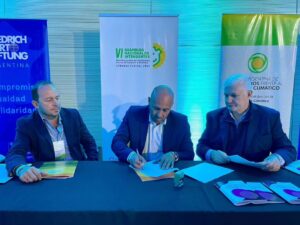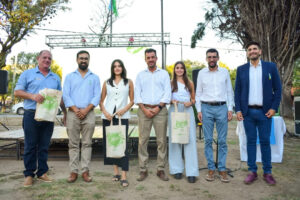The Argentine Network of Municipalities against Climate Change (RAMCC) called on the local governments of San Luis to strengthen their commitment to the transition towards resilient and low-carbon cities. Currently, three municipalities in the province have already joined the initiative: Villa de Merlo, La Punta, and the city of San Luis.
Comprising more than 300 municipalities nationwide, RAMCC has 14 years of experience in coordinating local public policies focused on environmental regeneration and efficient management of technical and economic resources. The invitation is open to all interested municipalities willing to share experiences and strengthen solid waste management through circular economy models.

Benefits of joining RAMCC
Municipalities that join the network to fight climate change can access various tools and opportunities supported by the Secretary of Environment and Sustainable Development:
- Strategic alliances: Enable the design of joint strategies for climate change mitigation. RAMCC is part of the Global Covenant of Mayors for Climate and Energy, promoting international collaboration.
- Climate planning: Technical support is provided for the development of Greenhouse Gas Inventories and Local Climate Action Plans. Villa de Merlo was the first municipality in San Luis to present its emissions inventory, setting a precedent in the region.
- National campaigns: Initiatives such as waste management and urban tree planting have led to the planting of 195,206 trees in 2024 and over 700,000 in the last four years.
- Continuous training: Training in energy efficiency, waste management, and urban agriculture, with access to a specialized educational platform.
- Dissemination and communication: Visibility of municipal work through digital media and specialized articles.

Commitment to the Paris Agreement
To join RAMCC, mayors must commit to developing a GHG emissions inventory, establish reduction strategies, and design a climate change adaptation plan. Additionally, local emissions must be reduced by at least the same percentage committed by the National Government in the Paris Agreement and its updates.
Thanks to the inclusion of new municipalities and their commitment in international forums, RAMCC has become a reference in climate policies, facilitating access to international funds for adaptation and mitigation projects. Through this initiative, San Luis has the opportunity to strengthen its climate action and move towards a more sustainable development.
What is the Paris Agreement?
The Paris Agreement is an international treaty that seeks to limit global warming and adapt to its effects. It was adopted in 2015 and entered into force in 2016.
Objectives
- Limit global warming to 1.5°C above pre-industrial levels
- Achieve a climate-neutral planet by mid-century
- Reduce greenhouse gas emissions
- Adapt to the impacts of climate change
Characteristics
- Legally binding for signatory countries
- Based on the best available science
- Includes a transparency and accounting system, a global balance mechanism every 5 years, and a mechanism to facilitate implementation and compliance
Implementation
- Countries must submit climate action plans to reduce their emissions
- Communicate their action plans every five years
- Increase their commitments over time
- Collaborate to adapt to the impacts of climate change
Benefits
- The Paris Agreement is a milestone in the multilateral process of climate change
- Essential for achieving the Sustainable Development Goals
Have you visited our YouTube channel yet? Subscribe now!

